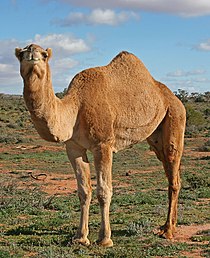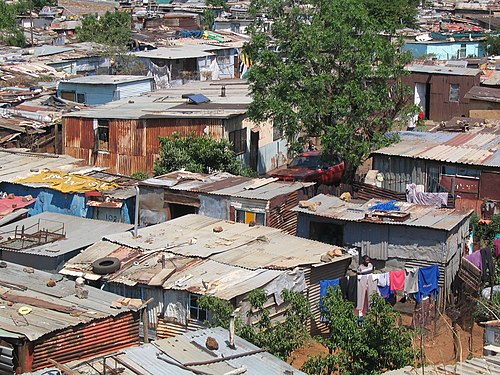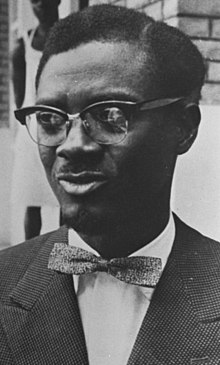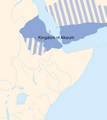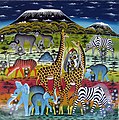Portal:Africa

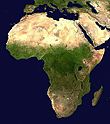

Africa is the world's second-largest and second-most populous continent after Asia. At about 30.3 million km2 (11.7 million square miles) including adjacent islands, it covers 20% of Earth's land area and 6% of its total surface area. With nearly 1.4 billion people as of 2021, it accounts for about 18% of the world's human population. Africa's population is the youngest among all the continents; the median age in 2012 was 19.7, when the worldwide median age was 30.4. Based on 2024 projections, Africa's population will reach 3.8 billion people by 2099. Africa is the least wealthy inhabited continent per capita and second-least wealthy by total wealth, ahead of Oceania. Scholars have attributed this to different factors including geography, climate, corruption, colonialism, the Cold War, and neocolonialism. Despite this low concentration of wealth, recent economic expansion and a large and young population make Africa an important economic market in the broader global context. Africa has a large quantity of natural resources and food resources, including diamonds, sugar, salt, gold, iron, cobalt, uranium, copper, bauxite, silver, petroleum, natural gas, cocoa beans, and.
Africa straddles the equator and the prime meridian. It is the only continent to stretch from the northern temperate to the southern temperate zones. The majority of the continent and its countries are in the Northern Hemisphere, with a substantial portion and a number of countries in the Southern Hemisphere. Most of the continent lies in the tropics, except for a large part of Western Sahara, Algeria, Libya and Egypt, the northern tip of Mauritania, and the entire territories of Morocco and Tunisia, which in turn are located above the tropic of Cancer, in the northern temperate zone. In the other extreme of the continent, southern Namibia, southern Botswana, great parts of South Africa, the entire territories of Lesotho and Eswatini and the southern tips of Mozambique and Madagascar are located below the tropic of Capricorn, in the southern temperate zone.
Africa is highly biodiverse; it is the continent with the largest number of megafauna species, as it was least affected by the extinction of the Pleistocene megafauna. However, Africa also is heavily affected by a wide range of environmental issues, including desertification, deforestation, water scarcity, and pollution. These entrenched environmental concerns are expected to worsen as climate change impacts Africa. The UN Intergovernmental Panel on Climate Change has identified Africa as the continent most vulnerable to climate change.
The history of Africa is long, complex, and varied, and has often been under-appreciated by the global historical community. In African societies the oral word is revered, and they have generally recorded their history via oral tradition, which has led anthropologists to term them oral civilisations, contrasted with literate civilisations which pride the written word. During the colonial period, oral sources were deprecated by European historians, which gave them the impression Africa had no recorded history. African historiography became organized at the academic level in the mid-20th century, and saw a movement towards utilising oral sources in a multidisciplinary approach, culminating in the General History of Africa, edited by specialists from across the continent. (Full article...)
Selected article –
Diani Beach is a beach on the Indian Ocean coast of Kenya. It is located 30 kilometres (19 mi) south of Mombasa, in Kwale County. (Full article...)
Featured pictures –
Did you know (auto-generated) -

- ... that one way to tell the African dusky flycatcher apart from the ashy flycatcher is that the former is "cuter"?
- ... that Agri-Expo is the oldest agricultural society in Africa?
- ... that Freedom of Religion South Africa filed an unsuccessful lawsuit to keep child spanking legal?
- ... that American doctor Cory Synhorst SerVaas believed that high-lysine corn could help end hunger in Africa, end famine, and stop protein deficiency despite only being fed to livestock and poultry?
- ... that Bea Hines, the first African-American woman to become a reporter at the Miami Herald, was sent to report on a riot on her first day at work?
- ... that in the aftermath of the American Civil War, the only Black-led organization providing teachers to formerly enslaved people was the African Civilization Society?
Categories
Selected biography –
Patrice Émery Lumumba (/pəˈtriːs lʊˈmʊmbə/ ⓘ pə-TREESS luu-MUUM-bə; born Isaïe Tasumbu Tawosa; 2 July 1925 – 17 January 1961) was a Congolese politician and independence leader who served as the first prime minister of the Democratic Republic of the Congo (then known as the Republic of the Congo) from June until September 1960, following the May 1960 election. He was the leader of the Congolese National Movement (MNC) from 1958 until his assassination in 1961. Ideologically an African nationalist and pan-Africanist, he played a significant role in the transformation of the Congo from a colony of Belgium into an independent republic.
Shortly after Congolese independence in June 1960, a mutiny broke out in the army, marking the beginning of the Congo Crisis. After a coup, Lumumba attempted to escape to Stanleyville to join his supporters who had established a new anti-Mobutu state called the Free Republic of the Congo. Lumumba was captured en route by state authorities under Joseph-Désiré Mobutu, sent to the State of Katanga and, with the help of Belgian partisans, tortured and executed by the separatist Katangan authorities of Moïse Tshombe. He was seen as a martyr for the pan-African movement. In 2002, Belgium formally apologised for its role in the execution. (Full article...)
Selected country –
 |
 |
||

| |||
Sudan (or The Sudan), officially the Republic of the Sudan or Republic of Sudan (Arabic: السودان as-Sūdān), is the largest African and Arab country by area. The country is situated at a crossroads between the Horn of Africa and the Middle East. It is bordered by Egypt to the north, the Red Sea to the northeast, Eritrea and Ethiopia to the east, Kenya and Uganda to the southeast, the Democratic Republic of the Congo and the Central African Republic to the southwest, Chad to the west, and Libya to the northwest. It is the sixteenth largest country in the world by area.
In Sudan's 1993 census, the population was recorded to be 25 million. No comprehensive census has been carried out since then due to the continuation of the Second Sudanese Civil War. A 2006 United Nations estimate put the population at about 37 million. The population of metropolitan Khartoum (including Khartoum, Omdurman, and Khartoum North) is growing rapidly and is estimated at about 5 to 7 million, including around 2 million displaced persons from the southern war zone as well as western and eastern drought-affected areas. (Read more...)
Selected city –

Ouagadougou or Wagadugu (/ˌwɑːɡəˈduːɡuː/, Mossi: Waogdgo Mossi: [ˈwɔɣədəɣʊ], Dyula: Wagadugu, French: Ouagadougou French: [waɡaduɡu]) is the capital of Burkina Faso, and the administrative, communications, cultural and economic centre of the nation. It is also the country's largest city, with a population of 2,415,266 in 2019. The city's name is often shortened to Ouaga. The inhabitants are called ouagalais. The spelling of the name Ouagadougou is derived from the French orthography common in former French African colonies.
Ouagadougou's primary industries are food processing and textiles. It is served by an international airport and is linked by rail to Abidjan in the Ivory Coast and, for freight only, to Kaya. There are several highways linking the city to Niamey, Niger, south to Ghana, and southwest to Ivory Coast. Ouagadougou has one of West Africa's largest markets, which burned down in 2003 and has since reopened with better facilities and improved fire-prevention measures. Other attractions include the National Museum of Burkina Faso, the Moro-Naba Palace (site of the Moro-Naba Ceremony), the National Museum of Music, and several craft markets. (Full article...)
In the news
- 18 January 2025 –
- Ghanian soldiers open fire on illegal miners at a gold mine in Ashanti Region, killing seven people. Ghanian president John Mahama calls for an investigation into the incident. (AP)
- 18 January 2025 – 2025 Suleja fuel tanker explosion
- At least 86 people are killed and several others are injured when a fuel tanker overturns on a highway in Suleja, Niger State, Nigeria, and later explodes when people gather to collect the spilled fuel. (Vanguard) (The Straits Times)
- 17 January 2025 –
- Three people are killed and seven others are injured in clashes with security forces in Juba and Aweil, South Sudan, with three Sudanese-owned houses set on fire in Aweil. This comes after videos emerged allegedly showing Sudanese soldiers killing South Sudanese civilians in Wad Madani, Sudan. (BBC News)
- The Zimbabwean Ministry of Health reports that a new cholera outbreak that started in December 2024 has reached eight districts and infected nearly 300 people, causing one death. (DW)
- 16 January 2025 – Somali Civil War, War against the Islamic State
- The Puntland Security Force claims to have captured a training facility used by ISIL militants, with over forty ISIL fighters killed following heavy fighting. (The Eastleigh Voice)
- Thousands of families are displaced as the military campaign intensifies, forcing locals to flee their homes in Bari region of Puntland, Somalia. (Idil News) (Horn Observer)
Updated: 9:05, 21 January 2025
General images -
Africa topics
More did you know –
- ... that at approximately 5,000 years old, the Lothagam North Pillar Site is thought to be the earliest and largest monumental cemetery in eastern Africa?
- ... that a 2020 study found that African countries which allowed foreign funding of NGOs had a higher voter turnout?
- ... that Essop Moosa, who was of Indian origin, became the first non-white player to play for an all-white soccer team in South Africa, appearing under a pseudonym?
- ... that the Seventh German Inner Africa Research Expedition served as cover for a secret First World War espionage mission?
Related portals
Major Religions in Africa
North Africa
West Africa
Central Africa
East Africa
Southern Africa
Associated Wikimedia
The following Wikimedia Foundation sister projects provide more on this subject:
-
Commons
Free media repository -
Wikibooks
Free textbooks and manuals -
Wikidata
Free knowledge base -
Wikinews
Free-content news -
Wikiquote
Collection of quotations -
Wikisource
Free-content library -
Wikispecies
Directory of species -
Wikiversity
Free learning tools -
Wikivoyage
Free travel guide -
Wiktionary
Dictionary and thesaurus













